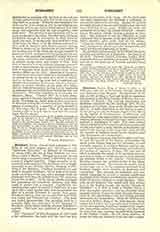

Ethelbert, Saint, date of birth unknown; d. 794; King of the East Angles, was, according to the “Speculum Historiale” of Richard of Cirencester (d. about 1401), the son of King Ethelred and Leofrana, a lady of Mercia. Brought up in piety, he was elected king on Ethelred’s death, ruled wisely, and was a man of singular humility. Urged to marry, he declared his preference for a life of celibacy, but at length consented to woo Altrida (Alfrida), daughter of Offa, King of the Mercians. Leofrana foreboded evil and tried to dissuade Ethelbert; but in spite of an earthquake, an eclipse of the sun, and a warning vision, he proceeded from Bury St. Edmunds to Villa Australis, where Offa resided. On his arrival Altrida expressed her admiration for Ethelbert, declaring that Offa ought to accept him as suzerain. Cynethryth, the queen-mother, urged by hatred of Ethelbert, so poisoned Offa‘s mind against him, that he accepted the offer of a certain Grimbert to murder their guest. Ethelbert, having come for an interview with Offa, was bound and beheaded by Grimbert. The body was buried ignominiously, but, revealing itself by a heavenly light, was translated to the cathedral at Hereford, where many miracles attested Ethelbert‘s sanctity. The head was enshrined at Westminster Abbey.
The “Chronicon” of John Brompton (fl. 1437) adds a few particulars: the body with the head was first buried on the banks of the Lugg. On the third night the saint commanded one Brithfrid, a nobleman, to convey his relics to Stratus-way. During the journey the head fell out of the cart and healed a man who had been blind for eleven years. Finally the body was entombed at Fernley, the present Hereford. According to Brompton, Altrida became a recluse at Croyland. Offa repented of his sin (Matthew of Paris represents Offa as ignorant of the plot till after Ethelbert‘s murder), gave much land to the martyr, “which the church of Hereford holds to the present day”, founded St. Albans and other monasteries, and made his historic pilgrimage to Rome.
St. Ethelbert figures largely in the Missal, Breviary, and Hymnal of the Use of Hereford. His feast is on May 20. Thirteen English churches, besides Hereford cathedral, are dedicated in honor of Ethelbert; and one of the gateways of Norwich cathedral bears his name.
PATRICK RYAN

